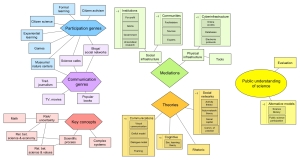On to my next exam reading list, which is focused on discourse communities, and the use of new media technologies and visuals in these communities.
Charles Kostelnick and Michael Hassett’s Shaping Information: The Rhetoric of Visual Conventions wasn’t exactly what I expected. It presents a rhetorical view of visual design, in a framework of discourse communities. I think I was expecting more specific recommendations from this book, but it does provide a good link between the visual and community-focused materials on my list:
Summary: The authors attempt to construct a framework for analyzing visual rhetoric, based on conventions used in various genres, the social forces that shape those conventions, and the situation-specific interpretation of conventions by users/readers. Visual conventions frame our understanding of the world; they make design coherent and provide shortcuts for interpretation by readers. Three types of factors shape conventions: discourse community (e.g., disciplinary, cultural), rhetorical (e.g., pragmatic, imitation), and practical (e.g., cost, laws). Conventions are generated within discourse communities (and learning conventions is required for joining those communities); they’re mutable but can appear permanent. There are different levels of understanding conventions, e.g., using a physics formula on a t-shirt to evoke “geekiness;” increasing centrality in a specialist d.c. leads to more complex understanding of codes. Conventions have shifting “currency” (size of user pool + frequency of use); designers must make rhetorical choices about what to use. Finally, conventions can be hard to see, because they’re usually deployed with other conventions, and especially in specialist discourse can seem “natural.”
Comments: Emphasis is on the discourse community process as the basis for discussion of convention use in different genres; there’s a large social aspect to visual design for the authors. They discuss the ways conventions can either simplify or complicate the act of perception, but do not include a lot of detail from empirical studies; they do include a chapter on the types of convention “breakdown” that can occur (designers and users are in different d.c.’s, conflict with other conventions in the same work, etc.). They also discuss evolution of conventions, framed by the ways that the discourse communities that gave rise to those conventions changed.
Links to: Tufte 1, 2 (K&H would call his a specific type of rhetoric)
